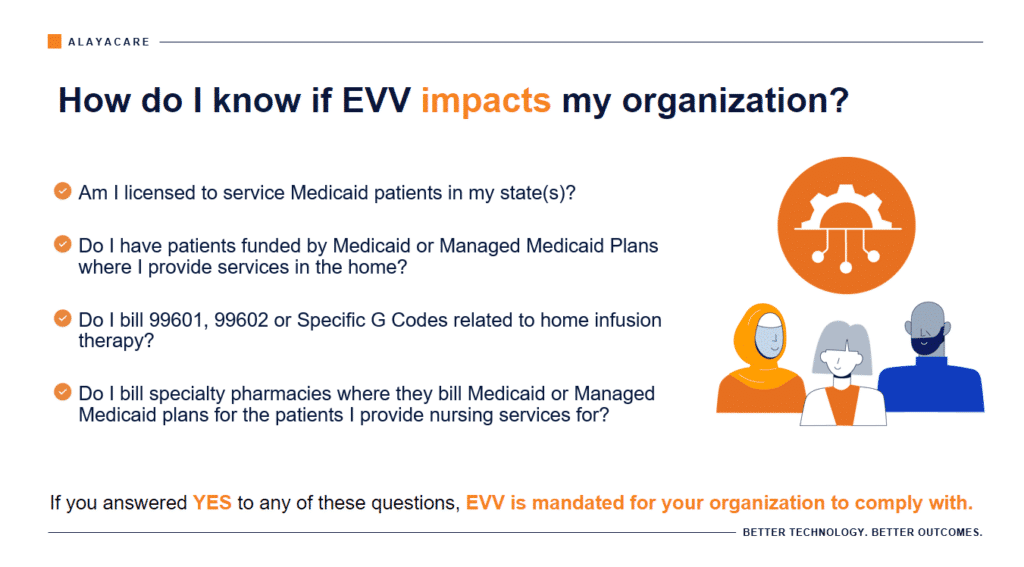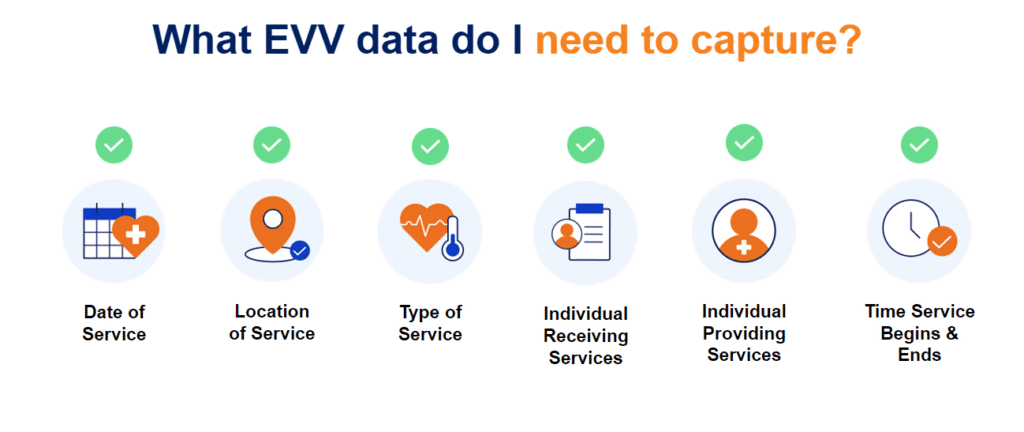Blog
EVV & me: How to stay compliant as a home infusion nursing agency [Webinar Recap]
![EVV & Me_ How to Stay Compliant as a Home Infusion Nursing Agency EVV & Me: How to Stay Compliant as a Home Infusion Nursing Agency [Webinar Recap]](https://alayacare.com/wp-content/uploads/2023/10/EVV-Me_-How-to-Stay-Compliant-as-a-Home-Infusion-Nursing-Agency-1024x576.png)
Questions arise for home health agencies each time the Centers for Medicare and Medicaid Services (CMS) issues a final rule that impacts those providing skilled nursing services, especially home infusion nursing agencies and specialty pharmacies. The latest CMS concerns have surrounded electronic visit verification (EVV), or really, how exactly it applies to home infusion organizations.
In our latest webinar, AlayaCare’s experts in home infusion and skilled nursing, Kaila Raimondo and Alex Ion discussed how specialty pharmacies and nursing agencies can operate efficiently and compliantly when navigating the changing landscape of EVV regulations.
As the new year quickly approaches, tune into the EVV webinar to get your organization prepared.
What is electronic visit verification (EVV)?
Electronic visit verification, more commonly referred to as EVV for short, is a tracking system that requires electronic verification of when an individual receives Medicaid-funded personal care or home health services. It’s primarily employed as a pre-payment or post-payment validation system to determine whether the state Medicaid agency or managed care plan (MCP) should pay that claim.
“The state wants to ensure that caregivers or nurses were at the locations they said they were with patients at those scheduled times and were able to provide verification and management of that detail. All of this stems from the passing of the 21st Century Cures Act, and is used to control fraud, waste, and abuse of the Medicaid and managed Medicaid system,” explains Kaila Raimondo.
Does EVV apply to your organization?
“Home health and skilled nursing services have now been subject to electronic visit verification, with most states rolling out their initial deadlines come July first of this year. But personal care services have been under electronic visit verification mandates since 2021,” adds Kaila. Generally speaking, EVV will apply to your organization if you answer yes to any of these four questions:

What data must be sent to stay compliant?
Six pieces of electronic visit verification data must be sent to state aggregators to remain compliant as a specialty pharmacy or home infusion agency providing nursing services, including the date, location, and type of services provided, the name of the individual receiving the services, the name of the individual providing the services, and the time the services begin and end.

“You’ll hear the words ‘state aggregators’ thrown around a lot,” mentions Kaila in reference to the tools used to transmit state specific EVV data to CMS. “A lot of the names, like Sandata, HHA Exchange, Telus, Therapp, and others, will ring a bell. This is where alternative vendors like AlayaCare will ultimately send data through those state-managed solutions.”
“Check with your current provider to ensure the appropriate information is accurately tracked directly in their system, as well as make sure your staff are properly trained on how to register visit data correctly,” directs Alex Ion. “This can be as simple as clocking in or out of a mobile provider app, but always check with your provider to make sure that the correct processes are followed.”
How can you simplify EVV management?
Understanding and complying with Electronic Visit Verification (EVV) mandates in the home care industry can seem daunting. However, it’s an essential part of providing high-quality care and ensuring your organization remains compliant. Here are some recommended steps to take:
- Ensure you have a robust system in place to track the data required for EVV. This is crucial, as it forms the foundation of your compliance efforts. It’s equally important to provide your front-line staff with the necessary tools for efficient data capture. They are your first line of defense in maintaining compliance, and their role cannot be understated.
- Note: It’s wise to verify with your current provider that they accurately track the appropriate information. This helps to avoid any potential issues down the line and ensures you’re on the right track from the start.
- Make sure you’re aware of your state’s EVV compliance deadlines. This will help you plan your compliance efforts effectively and avoid any last-minute scrambling.
- Start identifying your current or potential patients that require EVV data collection.
- Work closely with your referral partners or payors to align EVV expectations. This collaborative approach will ensure compliance and foster strong relationships within the industry.
“Any nursing agencies that are currently leveraging systems that register the correct visit data directly can utilize it to meet EVV guidelines, and options do exist for this data to be securely provided to pharmacies,” explains Alex. “AlayaCare Marketplace allows nursing agencies and specialty pharmacies to interface, send, and receive referrals alongside completed nursing data.”
To explore how the AlayaCare Marketplace can simplify EVV for your home infusion nursing agency, tune into the webinar!


